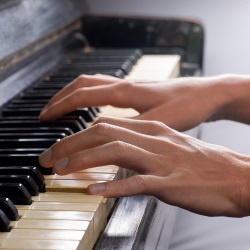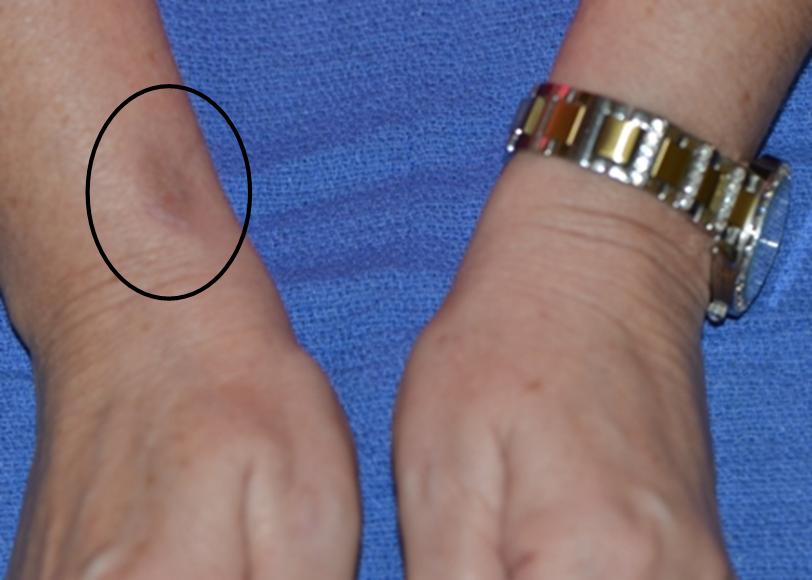Expert Treatment for de Quervain's Tendonitis at Nebraska Hand & Shoulder Institute, P.C.
Experience relief from the persistent pain of de Quervain's tendonitis with our tailored treatment options at Nebraska Hand & Shoulder Institute. Specializing in both treatment interventions for de Quervain's tendonitis, we are experts in relieving wrist tendonitis and enhancing the overall quality of life. You can learn more about de Quervain's tendonitis below, or contact us today to schedule an appointment.
Understanding de Quervain's Tendonitis
De Quervain's Tendonitis may manifest as discomfort on your wrist's thumb side, which can be attributed to the tightening of the band over two thumb-lifting tendons. Pain may radiate from the thumb's base towards the top of the forearm, often coupled with visible swelling and a grating sensation over the tendon.
This condition is nine times more common in women and often co-occurs with carpal tunnel syndrome and trigger finger. Early diagnosis and appropriate treatment can provide significant relief.

Non-Surgical Tendonitis Treatment
An initial approach to treating de Quervain's often includes the injection of a corticosteroid preparation into the tendon sheath. Cortisone injections are a common treatment, providing significant symptom alleviation within days to weeks, however they are often painful.
For cases with prominent swelling and grating of the tendon, thumb splints, and analgesics might also be prescribed for interim relief.
Unfortunately, these treatments only address the symptoms and do not provide long-term relief by addressing the cause of de Quervain’s.
Wrist Tendonitis Surgery
In approximately one-third to one-half of cases, surgical intervention is necessary. This outpatient procedure is performed under local anesthesia and has a success rate of over 90%. Patients often report that the post-surgery discomfort is less than that following a cortisone injection.
The surgical procedure entails completely cutting the pinched tendon sheath, which frees up the tendon. It's important to note that the tendon may be slightly compressed due to the pressure from the tendon sheath. This compression resolves once the tendons are given space to glide.
WARNING: MAY CONTAIN GRAPHIC IMAGES
Risks of Surgery
Potential surgical risks encompass infection (1 in 200 cases), temporary numbness due to the need to slightly move a nerve during the procedure, and possible lingering tenderness at the surgical site.
Fallacy of Work-Relatedness
Studies on development, natural history, and the treatment of de Quervain's do not tie into the workplace or the heavy use of one's hand in repetitious activity as causative.
In one series of 55 patients, 50 of the 55 patients with de Quervain's were not involved in occupations involving repetitive use of the hands or wrist (33% were retired, 29% were clerical workers, 13% were doing assembly/light work, 7% were doing heavy labor, 18% had just delivered children).

Discoloration that could be permanent from a cortisone injection.
About Corticosteroids
Corticosteroid preparations used in a medical setting are manufactured by pharmaceutical companies. These are based on cortisol, a hormone naturally produced by the adrenal glands. Increased duration of action and strength of the drug are achieved by making a slight change to the molecule.
The drugs commonly used are: dexamethasone, beclomethasone, prednisolone, and triamcinolone. They are about 25-30 times stronger than cortisol. These drugs have been used for injection since about 1951, with rare complications occurring. Non-operative "conservative" treatment of trigger finger and de Quervain's with cortisone injections may result in side effects. These include: temporary pain increase ("flare"), fat atrophy, skin depigmentation, hot flashes (in women), plus local injection pain.
Frequently Asked Question
Question: Is de Quervain’s tendinosis caused by work? I have heard that it is unlikely.
Answer: There probably is some relationship of certain tasks to the development of de Quervain’s but they haven’t been identified. Unhappy workers blaming it on their keyboard activities need to look in another direction. The thumb only strikes the space bar during typing maneuvers. That is not an activity that would be anticipated to cause any problem with the thumb, let alone de Quervain’s.
Anderson, Bruce Carl, et al, “Treatment of de Quervain’s tenosynovitis with corticosteroids.” Arthritis and Rheumatism, Vol. 34, No. 7, July 1991, pp. 793-798.
Badalamente, M.A., “Pathobiology of the Human A1 Pulley in Trigger Finger.” The Journal of Hand Surery, Vol. 16A, 1991, pp. 714-721.
Bishop, A.T., “Extensor Triggering in de Quervain’s Stenosing Tenosynovitis.” The Journal of Hand Surgery. Vol. 24A, 1999, pp. 1311-1314.
Dinham, J.M., Meggitt, B.F., “Trigger thumbs in children: a review of the natural history and indications for treatment in 105 patients.” Journal of Bone and Joint Surgery, Vol. 56B, No 1, 1974, pp. 153-155.
Doyle, J.R., Blythe, W.F., “The finger flexor tendon sheath and pulley: anatomy and reconstruction.” AAOS Symposium on Tendon Surgery in the Hand, St. Louis, 1975. The C.B. Mosby Company, pp. 81-87.
Doyle, J.R., “Anatomy of the Flexor Tendon Sheath and Pulleys of the Thumb.”, The Journal of Hand Surgery, Vol. 2, 1977, pp. 149-151.
Eastwood, D.M., Gupta, K.J., Johnson, D.P., “Percutaneous Release of Trigger Finger: An Office Prodedure.” Journal of Hand Surgery, Vol. 17A, 1992, pp. 114-117.
Ezaki, M., “Trigger Finger in Children.”, The Journal of Hand Surgery, Vol. 24A, 1999, pp. 1156-1161.
Fulcher SM, Hill, J.J.; “An Analysis of Patients with Multiple Trigger Digits.” [Poster] 56th Annual Meeting of the American Society for Surgery of the Hand Oct. 4, 2001, Seattle, WA.
Gray, R.G. and Gottlieb, N.L., “Hand flexor tenosynovitis in rheumatoid arthritis: prevalence, distribution, and associated rheumatic features.” Arthritis and Rheumatism, Vol. 20, No. 4, 1970, pp. 103-108.
Griggs, S.M., “Treatment of Trigger Finger in Patients with Diabetes Mellitus.” The Journal of Hand Surgery, Vol. 20, 1995, pp. 787-789.
Harvey, Francis J., et al, “deQuervain’s disease: surgical and non-surgical treatment.” Journal of Hand Surgery, Vol. 15A, No. 1, January 1990, pp. 83-87. (Diagram 4).
Hoffmann, R., “Open Versus Percutaneous Release of the A1-Pulley for Stenosing Tendovaginitis: A Prospective Randomized Trial.”, Techniques in Hand & Upper Extremity Surgery, Vol. 12, 2008, pp. 183-187.
Hollander, J.L., et al, “Hydrocortisone and cortisone injected into arthritic joints, comparative effects of and use of the hydrocortisone as a local anti-arthritic.” JAMA, Vol. 147, 1951, pp. 1629-1635.
Jackson, W.T., et al, “Anatomical variations of the first extensor compartment of the wrist: a clinical and anatomical study.” Journal of Bone and Joint Surgery, Vol. 68A, No. 6, July 1986, pp. 923-926.
Lane, L.B., “Commentary: Percutaneous Release of the First Annular Pulley.” The Journal of Hand Surgery, Vol. 20, 1995, pp. 785-786.
Lapidus, P.W., “Stenosing tenovaginitis.” Surgical Clinics of North America, Vol. 33, 1953, pp. 1317*1347.
Lubahn, J., “Complications of Open Trigger Finger Release.”, The Journal of Hand Surgery, Vol. 35A, 2010, pp. 594-596.
Medl, W.T., “Tendonitis, tenosynovitis, trigger fingers, and deQuervain’s disease.” Orthopaedic Clinic of North America, Vol. 1, No. 2, 1970, pp. 375-382.
Otto, N., Wehby, M., et al, “Steroid injections for tenosynovitis in the hand.” Orthopaedic Review, Vol. 15, No. 5, May 1986.
Patel, M.R., Bassini, L., “Trigger fingers and thumb: when to splint, inject or operate” Journal of Hand Surgery Vol. 17A, No. 1, Jan. 1992, pp. 110-113.
Patel, M.R., “Percutaneous Release of Trigger Digit With and Without Cortisone Injection.” The Journal of Hand Surgery, Vol. 22A, 1997, 150-155.
Peimer, C.A., “Release of the Sixth Dorsal Compartment.” The Journal of Hand Surgery, Vol. 19A, 1994, pp. 599-601.
Pratt, H.L., Bunnell, S., “Use of compound F (hydrocortisone in op) in operative and non-operative conditions of the hand.” Journal of Bone and Joint Surgery, Vol. 35, 1953, pp. 94-102.
Roth, J.H., “Percutaneous A1 Pulley Release: A Cadaveric Study.” The Journal of Hand Surgery, Vol. 20A, 1995, 781-784.
Sampson, S.P., et al, “Pathobiology of human A-1 pulley in trigger finger.” Journal of Hand Surgery, Vol. 16A, 1991, pp. 714-721.
Tanaka, J., “Percutaneous Trigger Finger Release.”, Techniques in Hand and Upper Extremity Surgery, Vol. 3, 1999, pp. 52-57.
Weilby, A., “Trigger finger: incidence in children and adults and the possibility of a predisposition in certain age groups.” Acta Orthopaedics Scandinavia, Vol. 41, 1970, pp. 419-427.
Weiss, A.C., “Treatment of De Quervain’s Disease.” The Journal of Hand Surgery, Vol. 19A, 1994, pp. 595-598.
Witczak, J.W., “Triggering of the Thumb with de Quervain’s Stenosing Tendovaginitis.” The Journal of Hand Surgery, Vol. 15, 1990, pp. 265-268.
Witt,J. “Treatment of de Quervain Tenosynovitis: A Prospective Study of the Results of Injection of Steroids and Immobilization in a Splint.” Journal of Bone & Joint Surgery, Vol. 73, 1991, pp. 219-222
Woods, T.H.E., “deQuervain’s disease: a plea for early operation: a report on 40 cases.” British Journal of Surgery, Vol. 51, No. 5, May 1964, pp. 358-359.



